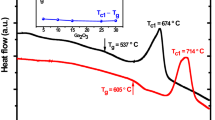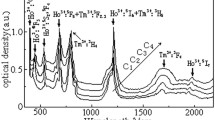Abstract
Both titanium and germanium were introduced into silicon dioxide system by sol-gel method to move its region of anomalous dispersion caused by IR resonance absorption towards the wavelength of CO2 laser. It is indicated by IR absorption spectra that as the content of SiO2 decreases in this glass system TiO2 and GeO2 tends to exist in their own phases. As for the gel glass with a composition of 40 SiO2·30TiO2·30GeO2, when the temperature is below 600°C, germanium atoms exist mainly in Ge−O−Ge bonds. With the temperature increasing from 800°C to 1000°C, titanium atoms in Si−O−Ti bonds abmost transform into Ti−O−Ti bonds. Furthermore, a large number of Si−O−Ti and Si−O−Ge bonds formed when the temperature approaches 800°C, which makes a notable IR absorption band round the wavelength of CO2 laser. Therefore, sol-gel based SiO2−TiO2−GeO2 gel glass is a candidate material for CO2 laser hollow waveguide.
Similar content being viewed by others
References
T Hidaka. Loss Calculations of the Hollow-core, oxide-glass-cladding, Middle-infrared Optical Waveguide.J. Appl. phys., 1982, 53(1): 93–97
Steven J Saggese, Tanes A Harrington, and George H Sigel, Jr. Attenuation of Incoherent Infrared Radiation in Hollow Sapphire and Silica Waveguides.Optics Letters, 1991, 16(1): 321–325.
N Croitoru, A Inbeg, M Oksman, M. Ben-David. Hollow Silica, Metal and Plastic Waveguides for Hard Tissue Medical Application.SPIE, 2977: 30–34.
C A Worrell. Infrared Optical Constants for CO2 Laser Waveguide Materials.Journal of Materials Sciences, 21 (1981): 781–787.
T Hidaka, T Morikawa, and J Shinada. Hollow-core Oxide-glass Cladding Optical Fibers for Middle-infrared Region.J. Appl. Phys, 1981, 52(7): 4467–4471.
Han Jian-jun, Liu Jixiang, Zhou Xue-dong, Mao Yu-lan. Influence of Sb2O3 and PbO Content on Glass Properties of SiO2-Based for Hollow Waveguides.Journal of Wuhan University of Technology—Mater. Sci. Ed., 1998, 13(4): 50–55.
T Hidaka, K Kumada, J Shimada, and T Morikawa. GeO2−Zno−K2O Glass as the Cladding Material of 940cm−1 CO2 Laser-light TranSmitting Hollow-core Waveguide.J. Appl. Phys., 1982, 53(8): 5484–5490.
I Haruvi-Busnach, J Dror, and N Critoru. Chalcogenide Glasses Ge−Sn−Se, Ge−Se−Te, and Ge−Sn−Se−Te for Infrared Optical Fibers.J. Mater. Res., 1990, 5(6): 1215–1223.
Nobuhiro Nagano, Mitsunori Saito, Mitsunobu Miyagi, Nobuyoshi Baba, and Naruhito Sawanobori. TiO2−SiO2 Based Glasses for Infared Hollow Waveguides.Applied Optics, 1991, 30(9): 1074–1079.
Yuuji Hirai, Takumi Fukuda and Kanji Kubota. Optical Properties of SiO2−GeO2 Glasses Made by Sol-gel Method.Journal of Non-Crystalline Solids, 1986, 88: 431–435.
S Shibata, T Kitagwa, F Hana, W A Optical and M Horiguchi. Fabrication of SiO2−GeO2 Core Optical Fibers by the Sol-gel Method.Journal of Non-Crystalline Solids, 1986, 88: 354.
Author information
Authors and Affiliations
Additional information
JING Cheng-bin: Born in 1974.
This work was partly financially supported by the Foundation of Key Teachers of Ministry of Education, China.
Rights and permissions
About this article
Cite this article
Cheng-bin, J., Xiu-jian, Z., Jian-jun, H. et al. IR spectra analysis of SiO2−TiO2−GeO2 gel glass of CO2 laser transmitting hollow waveguide. J. Wuhan Univ. Technol.-Mat. Sci. Edit. 17, 54–57 (2002). https://doi.org/10.1007/BF02838418
Received:
Issue Date:
DOI: https://doi.org/10.1007/BF02838418




